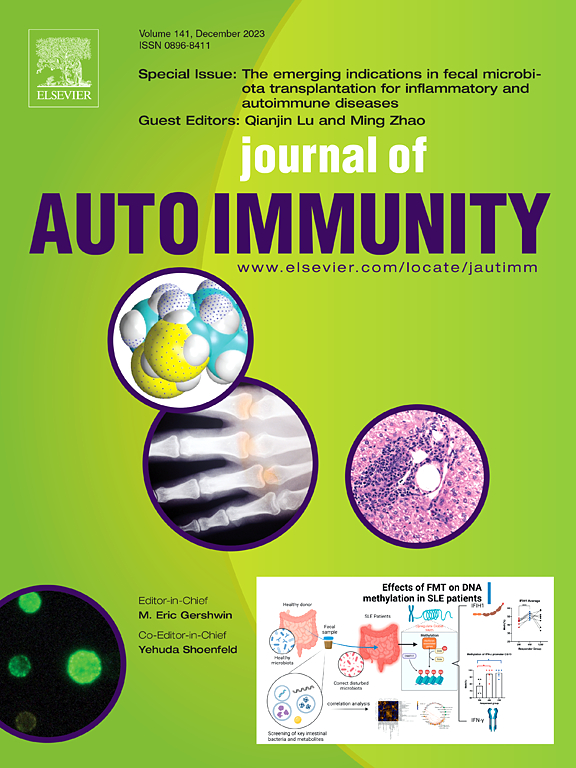Janus激酶抑制可预防LEW.1WR1大鼠自身免疫性糖尿病。
IF 7
1区 医学
Q1 IMMUNOLOGY
引用次数: 0
摘要
大量研究强调I型干扰素(IFN)应答在1型糖尿病中的重要作用。I型IFN信号的缺失与LEW.1WR1大鼠自身免疫性糖尿病发病率的部分降低有关。我们试图用I型IFN α/β受体(IFNAR)敲除大鼠来描述驱动糖尿病的I型IFN独立机制。用多肌苷:多胞酸加克勒姆大鼠病毒诱导大鼠糖尿病。利用胰岛单细胞rna测序和糖尿病前期IFNAR 1-/-大鼠血液和脾脏细胞因子测量来确定在全球缺乏IFNAR信号传导的情况下驱动胰岛素的因素。胰岛免疫细胞富集Ccl4、Ccl5和Ifng。此外,糖尿病前期Ifnar1-/-大鼠脾脏白细胞介素-1 (IL-1)升高,血清IFN-γ升高。基于这些发现,用C-C趋化因子受体5型抑制剂、IL-1受体拮抗剂或核苷酸结合寡聚化结构域样受体家族pyrin结构域3抑制剂治疗大鼠,没有一种能预防糖尿病。Janus激酶抑制剂ruxolitinib可以阻断I型和II型干扰素驱动的信号传导,完全预防糖尿病,但只有从诱导时开始持续一段时间。酪氨酸激酶2抑制剂deucravacitinib也能显著预防糖尿病。我们得出结论,I型和II型ifn作为自身免疫性糖尿病的主要驱动因素协同作用,抑制这两种下游信号事件是预防疾病所必需的。本文章由计算机程序翻译,如有差异,请以英文原文为准。
Janus kinase inhibition prevents autoimmune diabetes in LEW.1WR1 rats
Numerous studies highlight the essential role of type I interferon (IFN) responses in type 1 diabetes. The absence of type I IFN signaling is associated with a partial reduction of autoimmune diabetes incidence in LEW.1WR1 rats. We sought to delineate type I IFN-independent mechanisms that drive diabetes using type I IFN α/β receptor (IFNAR) knockout rats. Rats were treated with polyinosinic:polycytidylic acid plus Kilham rat virus to induce diabetes. Single-cell RNA-sequencing of islets and cytokine measurements in blood and spleen from prediabetic Ifnar1−/− rats were employed to identify factors driving insulitis in the global absence of IFNAR signaling. Islet immune cells were enriched for Ccl4, Ccl5, and Ifng. In addition, interleukin-1 (IL-1) was increased in spleen, and IFN-γ was increased in serum from prediabetic Ifnar1−/− rats. Based on these findings, rats were treated with a C-C chemokine receptor type 5 inhibitor, an IL-1 receptor antagonist, or a nucleotide-binding oligomerization domain-like receptor family pyrin-domain containing 3 inhibitor, none of which prevented diabetes. The Janus kinase inhibitor ruxolitinib, which blocks both type I and II interferon-driven signaling, completely prevented diabetes, but only when given for a sustained period starting from the time of induction. The tyrosine kinase 2 inhibitor deucravacitinib also prevented diabetes to a significant degree. We conclude that type I and II IFNs act in concert as the main drivers of autoimmune diabetes and that inhibition of downstream signaling events for both is required for disease prevention.
求助全文
通过发布文献求助,成功后即可免费获取论文全文。
去求助
来源期刊

Journal of autoimmunity
医学-免疫学
CiteScore
27.90
自引率
1.60%
发文量
117
审稿时长
17 days
期刊介绍:
The Journal of Autoimmunity serves as the primary publication for research on various facets of autoimmunity. These include topics such as the mechanism of self-recognition, regulation of autoimmune responses, experimental autoimmune diseases, diagnostic tests for autoantibodies, as well as the epidemiology, pathophysiology, and treatment of autoimmune diseases. While the journal covers a wide range of subjects, it emphasizes papers exploring the genetic, molecular biology, and cellular aspects of the field.
The Journal of Translational Autoimmunity, on the other hand, is a subsidiary journal of the Journal of Autoimmunity. It focuses specifically on translating scientific discoveries in autoimmunity into clinical applications and practical solutions. By highlighting research that bridges the gap between basic science and clinical practice, the Journal of Translational Autoimmunity aims to advance the understanding and treatment of autoimmune diseases.
 求助内容:
求助内容: 应助结果提醒方式:
应助结果提醒方式:


